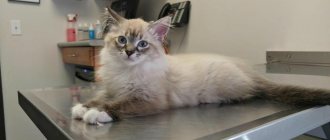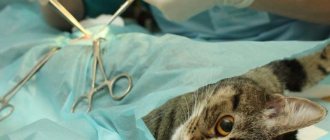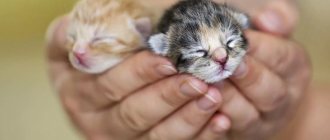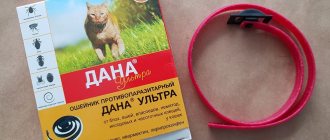Contrary to popular belief, the terms castration and sterilization are in no way related to the sex of the animal and imply various types of surgical interventions aimed at preventing unwanted reproduction of animals. Males and females can be castrated, as well as sterilized: in both cases, they lose the ability to reproduce.
Sterilization (vasectomy) is a surgical operation whose purpose is to create a barrier to the movement of cells involved in conception. In female animals, the fallopian tubes are ligated (this prevents the egg from getting from the ovaries to the uterus), and in cats and male dogs the spermatic cords are ligated, which prevents the release of sperm. During surgery, the genitals are not affected and continue to function as usual. Since hormonal levels are not disrupted, sterilized cats and dogs fully retain all instincts and the ability to mate, but pregnancy does not occur for obvious reasons.
Castration (ovariohysterectomy) – removal of the organs of the reproductive system: the uterus and ovaries (in cats and females) and testicles (in males and males). A variation of this operation is oophorectomy - removal of the ovaries while preserving the uterus. This practice is becoming increasingly rare: due to the high risk of complications and the development of cancer, the uterus is removed along with the ovaries.
To castrate or sterilize: that is the question
Owners of sterilized animals note that after the operation the behavior of their pets practically does not change, because the level of sex hormones remains at the same level. However, this does not mean that sterilization occurs absolutely without consequences for the animal’s body. At certain moments, real hormonal explosions can be observed when hormone concentrations approach critical values. Sterilized dogs and cats are more susceptible to stress and diseases of the genitourinary system. Significant changes are also observed in behavior: animals often become aggressive, are more difficult to train, and often lose weight for no apparent reason. According to statistics, more than half of animals with oncological pathology of the genital organs were previously sterilized.
Castration is the “gold standard” of veterinary medicine with minimal consequences for the risk of developing cancer of the uterus, ovaries and testicles. In 90% of cases, castration helps to cope with behavioral problems: aggression, dominance, increased excitability.
It has been proven that the life expectancy of neutered cats and dogs increases by an average of 1-3 years, and for some age-related diseases, castration is the only way to save a pet. Castration completely eliminates the risk of developing purulent inflammatory diseases of the uterus and ovaries, as well as prostatitis in cats. According to doctors, it is better to castrate animals at a young age, since surgery is a serious stress for the body, and recovery after surgery in adulthood is more difficult.
Definition
Sterilization of cats is limited to ligation of the fallopian tubes, and for cats this is fraught with ligation of the seminal ducts. Scientifically, this operation in cats is called a vasectomy. After the procedure, the animal’s genitals remain in place, they continue to produce hormones and function as usual. Sterilization of both cats and cats does not affect the sexual desire of animals, their instincts do not decrease or lose their intensity. In this case, animals can mate, but stop producing offspring.
Castration is an operation in which the complete removal of organs that are responsible for the reproduction of animals occurs. Thus, during castration in cats, the ovaries are removed along with the uterus (an operation called ovariohysterectomy) or just the ovaries alone (oophorectomy). Previously, nulliparous young cats had only their ovaries removed, but now they are trying to remove them along with the uterus, since recently gynecological problems are increasingly occurring even in young cats. In the event that only a cat's ovaries are removed, as a result of which the production of eggs ceases, all cat concerts immediately stop. In male cats, both testicles are removed during castration.
Castration: briefly about the operation
Thanks to modern veterinary drugs, the operation process is completely painless for cats and dogs. At the preparation stage, the veterinarian administers a drug intravenously for general anesthesia, during which the animal is immersed in a controlled drug sleep. Next, the surgical field is processed: the hair on the scrotum is shaved off, and the skin is treated with special disinfectants. Through two small incisions, the doctor ties the spermatic cord and removes the testes. The duration of the operation rarely exceeds 5-7 minutes; postoperative sutures do not require special treatment and, with rare exceptions, are not removed.
In cats and bitches, the castration technique is somewhat more complicated. The operation is abdominal: the uterus and ovaries are removed through a deep incision in the abdomen in the groin area. The duration of the operation is 30-40 minutes, after which the wound is sutured and a collar or a special blanket is put on the animal, which protects the wound from scratching and licking. In recent years, laparoscopic techniques have been increasingly used, making the operation less traumatic.
Postoperative care
Care after sterilization depends on the sex of the animal. In females, abdominal surgery is performed, stitches are applied, and the body recovers for 2-3 days. In males, the wound is shallow and heals faster; health returns to normal the very next day.
Care stages:
- Place in a safe, warm place. Under anesthesia, thermoregulation is disrupted, and the cat needs additional warmth. Coordination of movements is temporarily impaired: it is necessary to protect the animal from injury when it wakes up and tries to get up.
- Lay down a waterproof bedding or absorbent diaper: when recovering from anesthesia, involuntary urination is possible.
- Take care of your eyes. Cats under anesthesia do not close their eyes. To avoid postoperative conjunctivitis, you need to periodically instill saline into the eyes or close the animal’s eyelids every 5-10 minutes.
- Do not feed during recovery from anesthesia. Due to a violation of the swallowing reflex, only water can be given to a cat for the first 12 hours, to a cat for 24 hours.
- Protect stitches or wound. The male does not require special care for the wound; in case of scratching, a special collar can be worn. The female should wear a blanket or bandage for 7-10 days until the stitches are removed and 1-2 days until the final healing. If the wound becomes wet or festered, the surgical area is treated with an alcohol-free antiseptic. During the first 2-3 days, tissue swelling is allowed.
- Follow the veterinarian's recommendations. The animal may be prescribed additional antibiotics and undergo an additional examination to prevent complications.
Castration: arguments “FOR”
The advantages of castration of animals not involved in breeding are obvious and undeniable:
- increasing the duration of active longevity;
- positive changes in character (flexibility, obedience, lack of aggression);
- change in sexual behavior: lack of interest in individuals of the opposite sex;
- eliminating the risk of developing inflammatory and oncological diseases;
- In females, the incidence of breast cancer is greatly reduced.
Optimal age
Of course, a lot depends on the breed and individual characteristics of the animal. There are no specific deadlines for neutered cats. The average period of puberty in cats is 7-11 months. In any case, it will not be a mistake if the operation occurs a year later. This time is enough to avoid health problems in the future.
Castration, like any intervention in the body, brings certain hormonal and behavioral changes.
In any case, the sex life of your beloved pet will be a surprise for the owner. Even if the cat lives in an apartment and leads a passive lifestyle. An animal cannot resist its instincts and get carried away by a cat during a walk or run away on the street when arriving in a village or dacha.
Timely castration will avoid unnecessary frustration and loud cat concerts. Calls to search for a cat may be accompanied by aggressive behavior, uncontrolled marking of territory and loud meowing.
For clarity, we note obvious signs when a cat should be castrated and the maximum age for surgical or other intervention in natural processes:
- The cat has noticeably lost weight . It is worth keeping in mind adjustments for the time of year and breed. Cats, as a rule, lose weight closer to spring and summer because... There is no urgent need to maintain fat reserves. The animal refuses its favorite treats.
- Changes in behavior, mood. The cat snaps, behaves aggressively even with children, can “swear” at his favorite toys and damage furniture.
- The cat sleeps less and becomes restless. Night activity increases significantly, which causes problems for the owners.
- The cat watches the owners at the front door, meows loudly, and tries to sneak out into the street.
- The pet may rub its body parts against various objects . The emphasis will be heavily on the genitals and the fifth hairy point.
- Active marking of territory begins in the most unexpected and inappropriate places.
In general, a cat can be castrated up to the age of 3 years. But you shouldn’t delay or postpone the operation. Each time the pet’s mood and behavior will worsen. Even special tablets and drops will not help.
ATTENTION! There is an opinion among owners that a cat should be castrated only after the first mating. This is true for cats, but with males the situation is somewhat different. A cat that has satisfied its physical needs and then is deprived of this opportunity may experience enormous stress in the future.
Castration and urolithiasis
Numerous clinical studies have not revealed a direct relationship between castration and the incidence of urolithiasis. The main risk factor for the development of urolithiasis is excess weight caused by metabolic disorders. If a neutered animal is fed correctly, following the recommended diet, there is virtually no chance of stones forming in the urinary tract. Veterinary pharmacies and pet stores offer a wide range of specialized foods for neutered cats and dogs.
What should a sterilized cat eat?
- In the matter of controlling the pet’s weight, and therefore in preventing the development of diabetes in a cat, the owner will be helped by special diets that take into account the special energy needs of sterilized pets.
For example, the precisely balanced diet of Hill's™ Science Plan™ Sterilized Cat contains the “Weight Control Formula”, if the recommended feeding standards are followed, the pet can receive exactly as much energy as it can expend in a day. At the same time, the “Weight Control Formula” will take care of maintaining the cat’s muscle mass.
- Excess weight, imbalance of microelements and acidification of urine are the basis for the development of diseases of the lower urinary tract. These risks are also addressed in Hill's™ Science Plan™ Sterilized Cat Diet, which contains precisely balanced levels of phosphorus and magnesium to help prevent stone formation and inflammation in the urinary system.
- To ensure your pet is eating nutritiously while still enjoying the meal, offer a variety of Hill's™ Science Plan™ Sterilized Cat wet diets with chicken, salmon, trout and turkey as treats.
- Proper nutrition for spayed and neutered cats must also be appropriate for their age, so Hill's™ Science Plan™ Sterilized Cat diets include a diet for pets over seven years of age.
Mister cat recommends: advice to owners before and after surgery
The animal must be properly prepared for surgery. Before intervention, be sure to:
- At least a month and a half in advance, carry out deworming and get regular annual vaccinations.
- Make sure that the cat is completely healthy - does not have a cold, there are no systemic or infectious diseases.
- Consult with a specialist if your pet regularly takes medications and whether to discontinue them before and after surgery. Usually this is not required.
- If necessary, bathe the cat, comb it, trim its claws.
- Stop letting the animal outside at least two days before surgery to exclude the possibility of infection.
- Prepare in advance for the postoperative period - buy the necessary food, medications and a protective collar.
- Carry out a wet cleaning using disinfectants in the room where the animal will be after arriving from the veterinary clinic. Wash the litter or steam the cat's house.
- Stop feeding and remove water at least twelve hours before surgery.
Read about how to properly prepare a cat for castration.
When your pet returns home from the clinic you should:
- Arrange it in a comfortable, quiet, dark place. Provide rest and care, since within two days after anesthesia the animal may experience lightheadedness, nausea, and drowsiness.
- Do not water or feed the cat until six to twelve o'clock.
- Spend the first 24 hours with your pet and carefully monitor its condition.
- Protect other pets and children from interfering with the patient’s area.
- Ban the cat from going outside for up to a month. During this period, water procedures are contraindicated.
- Monitor the condition of the operated area; it should be dry and clean. In the first two days, the seams are treated with hydrogen peroxide, Chlorhexidine or Miramistin. If necessary, you can use a protective collar for animals.
- The condition of the seams should be checked twice a day. Initially they are red or pink, the intensity of the color should gradually decrease. If this does not happen or, on the contrary, they darken, this may be signs of infection. You need to urgently contact a veterinarian.
- Proper nutrition should be organized - initially soft wet food. Introduce dry food gradually. Always make sure your cat has water.
- Avoid constipation and physical exertion to prevent the risk of suture dehiscence.
We recommend reading the article about caring for a cat after castration.
Why is this necessary?
It is strictly forbidden to allow an uncastrated or unsterilized animal to roam. Don't console yourself with the thought that your cat is living a full life. They produce kittens - kittens that no one wants, no one loves, who will be doomed to live in fear all their lives in a big city. And they themselves will give birth to new kittens. Constant childbirth for a cat (and without your control, the cat will give birth at least twice, and maybe even four times a year) does not bring not only joy, but also no benefit. Childbirth is stressful for the body, and regular childbirth guarantees the cat an unpleasant “bouquet” of diseases.
Castration and sterilization are humane. Yes, this is an operation, yes, this is surgery, and yes, after this the pet will need additional care for some time. But at the same time, you do not poison your pet with poisonous pills, do not torment your pet with unmet needs, and do not breed kittens on the streets.
An unrealized sexual instinct in a pet is truly torture. This doesn't happen to people, but you can imagine what your pet might experience if you drink a lot of liquid and are unable to go to the toilet. It's not a pleasant feeling, and your pets definitely don't deserve it. And, besides, in the absence of fertilization, the cat’s hormonal levels constantly increase, which ultimately results in a number of very serious diseases, including cancer.
Advantages of castration and sterilization:
- The risk of many serious diseases is significantly reduced.
- The cat stops marking his territory.
- The animals stop screaming and imitating sexual intercourse.
- The pet's lifespan increases.
- The cat becomes calmer and more flexible.
- The pet does not need to go outside, which means it will not get lost, fight, get hit by a car or get into any other trouble.
- The endless appearance of new and new kittens stops.
- The pet's appearance and well-being improves.
- The cost of maintaining a pet is reduced (it consumes less food, it does not get injured or sick, which means there will be no need to regularly take it to the veterinarian).
What is sterilization?
Another method of surgical intervention that will protect the cat from unwanted offspring is called tubal occlusion . In other words, tubal ligation. Although, after this procedure, Murka will no longer be able to get pregnant, she will completely retain the production of sex hormones. And estrus will occur as regularly as before.
Today this method is rarely used, as it is associated with risks for the pet. First of all, a sterilized cat can develop inflammation of the uterus . In addition, the operation and the subsequent rehabilitation period in itself are a lot of stress for the pussy.
In addition to the disadvantages, sterilization has its positive aspects. During the operation, the animal does not suffer from prolonged exposure to anesthesia, since it is performed under local anesthesia.











